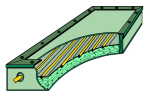Search engine visitors - click here to access entire "$ensible Home" web site
Click here to see a descriptive illustration of a do-it-yourself water-type solar collector.
Dear Jim: I have some scrap building materials around and I want to build several low-cost solar collectors. I want two of them for heating our water and our house and one for the swimming pool. What design is best? - S. C.

A: Although slightly more difficult to build than simple air-type solar collectors, water-type collectors are much more effective and versatile. Using scrap materials, you can build them for about $100 each. Super-efficient, hi-tech solar collector kits, like evacuated tubes, are available too.
A simple do-it-yourself water-type solar system can cut your water heating costs in half and add months of swimming pool use. Do not alternate the use of one collector between a pool and domestic water heating for health reasons. Water-type solar collectors circulate water (antifreeze solution in cold climates) to absorb and transfer the sun's heat. Plain old water is one of the best solar storage and transfer media available.
Swimming pool solar collectors are easiest to make and are highly recommended by most pool builders in Sydney because they circulate pool water directly through the collector.. Since the pool water is usually cooler than the air, heavy insulation and a glass cover are seldom needed. In contrast, when heating domestic water, the water temperature must be raised much higher than the air temperature. Insulation is needed on the back of the collector with single or double pane glazing on the top.
If you can repair a bathroom faucet, you should be able to build your own solar collector. Special electric water heater tanks, with built-in solar heat transfer coils, are available from major manufacturers like Rheem.
A thermosiphoning solar system design does not require a pump to circulate the water. An insulated storage tank is located above the collector so the solar-heated water (hot water is less dense) naturally flows up to it.
A simple active water-type collector consists of a shallow insulated box with a clear cover. When it is completed, locate it in a sunny location on the ground instead of on the roof. This provides easier access for cleaning the glass or plastic top. The plumbing is also easier to attach.
Make a shallow collector box frame from 2x6 pressure-treated lumber and plywood. Lay fiberglass insulation batts in the bottom of the box. This blocks heat loss out the back of the collector. Use easy-to-cut clear acrylic plastic or glass for the top. Make sure all the joints are caulked.
Run small copper pipes, painted flat black, vertically in the collector. Attach the pipes to larger horizontal (header) pipes at each end. For more efficiency, solder flat copper fins to the copper collector pipes.
Instant Download Update Bulletin No. 688 - do-it-yourself instructions for making a water-type solar collector, plumbing diagrams, required materials list, a list of 11 solar kit suppliers, descriptions and diagrams of types (thermosiphon or active systems), chart of recommended glazing systems, instructions on making a simple, do-it-yourself solar access viewer.
Dear Jim: My neighbor is a cleaning nut. She even cleans off the light bulbs in her lamps and claims it saves electricity. Is there really any point to dusting light bulbs? - J. G.
A: Actually, your neighbor may not be the nutty one in your neighborhood. Just a fine layer of dust on a light bulb can reduce the light output by 20%. This often forces you to switch on another lamp for adequate lighting.
Gently wipe off each light bulb with a damp cloth every several weeks. Unplug the lamp before wiping it. Make sure the bulb has been off for at least five minutes so that it is cool or the glass may crack.